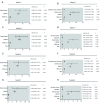Association between neurological deterioration and outcomes in patients with stroke
- PMID: 32055595
- PMCID: PMC6995739
- DOI: 10.21037/atm.2019.12.36
Association between neurological deterioration and outcomes in patients with stroke
Abstract
Background: Neurological deterioration (ND) shortly after stroke is common in Chinese patients. We aimed to determine the effects of ND during hospitalization on stroke prognosis.
Methods: We retrospectively reviewed files from the stroke registry of the Department of Neurology of Tianjin Huanhu Hospital between October 1, 2008, and December 31, 2015. The inclusion criteria were: age ≥18 years, diagnosis of acute ischemic stroke, and first-ever ischemic stroke occurring within 7 days prior to admission. ND was defined as an increase in the National Institutes of Health Stroke Scale (NIHSS) score by ≥4 points during hospitalization. Early neurological deterioration (END) was defined as an increase in the NIHSS score by ≥4 points between the baseline and 48-hour evaluations. Late neurological deterioration (LND) was defined as an increase in the NIHSS score by ≥4 points between the 48-hour and discharge evaluations. Multivariate regression was used to evaluate the relationship between early and late ND and short- and long-term outcomes. Primary and secondary outcomes based on the modified Rankin scale (mRS) were evaluated at 3 months and 1 year. Favorable and poor outcomes were defined as mRS scores of 0-2 and ≥3, respectively.
Results: A total of 9,650 patients were included. ND occurred in 293 patients (3.0%) during hospitalization. Among them, 192 (65.5%) were in the END group, and 101 (34.5%) were in the LND group. After adjusting for age, gender, and NIHSS scores, END was a significant independent predictor of poor outcome at both 3 months (primary outcome OR 8.069, secondary outcome OR 8.194) and 1 year (primary outcome OR 7.895, secondary outcome OR 5.679). The same pattern was seen in the LND group (3 months primary outcome OR 7.608, secondary outcome OR 6.349, 1-year primary outcome OR 10.793, secondary outcome OR 5.245).
Conclusions: ND during hospitalization, regardless of whether it occurs in the early or late period after stroke, is an independent predictor of poor prognosis.
Keywords: Acute stroke; follow-up; neurological deterioration (ND); outcome; predictor.
2020 Annals of Translational Medicine. All rights reserved.
Conflict of interest statement
Conflicts of Interest: The authors have no conflicts of interest to declare.
Figures


References
-
- Zinkstok SM, Beenen LF, Majoie CB, et al. Early deterioration after thrombolysis plus aspirin in acute stroke: a post hoc analysis of the Antiplatelet Therapy in Combination with Recombinant t-PA Thrombolysis in Ischemic Stroke trial. Stroke 2014;45:3080-2. 10.1161/STROKEAHA.114.006268 - DOI - PubMed
LinkOut - more resources
Full Text Sources
